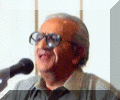![]()
![]()

![]()
|
The Dawn: June 02, 2006
Seniors did better than juniors Shafqat Tanvir Mirza
WORLD PUNJABI CONFERENCE — 2005; edited by Kanwal Mushtaq; pp (Punjabi-Urdu) 102 English 42; Price Rs150; published by Classic, 42-The Mall, Lahore. THE 12th World Punjabi Conference was held in Lahore from April 17-19 in which, according to the managers, some three hundred delegates from all over the world participated and presented their views mainly on PakistanIndia relations. This conference showed that the warmth seen at an earlier conference was missing this time for which perhaps both the neighbouring countries’ establishments are responsible. According to conflicting reports, at least 300 delegates were expected from India but only 12 were lucky enough to make it here. Only one of the Indian delegates, Dr Fatima Husain, presented her paper in English which has been included in the book. No other Indian delegate presented any paper. Most of them spoke formally in different sessions. This 144-page book consists of 13 papers (six in Punjabi, three in Urdu and four in English). Proceedings and columns appeared in some dailies. The declaration issued on the last day included all those demands which were once part of the charter of demands issued by the first Punjabi conference held in the early 1950s at Faisalabad (then Lyallpur). The moving spirit behind that activity was the late Dr Faqir Muhammad, also the editor of the first-ever Punjabi monthly published after independence. Their first success was that the study of Punjabi was included in Oriental languages courses in three tiers — Punjabi, Punjabi Alim and Punjabi Fazil. It helped many matriculate Punjabis for higher studies and some of them became PCS officers, advocates and lecturers in subjects other than Punjabi. Many private Punjabi colleges operated in many cities and at least two Punjabi literary magazines Punj Darya and Lehran owed their existence to these teaching centres. With the death of Chaudhry Afzal Khan, Punj Darya had gone with the wind. But Akhtar Husain has kept the flag of the monthly Lehran flying. During the difficult times the seniors also succeeded to get Punjabi introduced in school from class six to ten, and later on in FA (private). But it is unfortunate that the coming generation could not force the government to provide trained teachers to schools. Dr Faqir and Dr Baqir reproduced a sizable portion of classical poetry under the banner of Punjabi Academy. Then it was Punjabi Group of the Pakistan Writers’ Guild which got so active in the promotion of the Punjabi that it earned the wrath of the federal government. This was the first-ever organisation which started celebrating the anniversary of the great sufi poet of Lahore Shah Husain. The government sponsored Writers’ Guild closed down the Punjabi Group and in reaction two organisations, Majlis Shah Husain and Punjabi Adabi Sangat, cropped up which hotly pursued the cause of Punjabi. The Sangat is still alive and will be celebrating its 43rd foundation anniversary this month, while the Majlis had set a precedent which is yet to be matched. It may be mentioned that the closure of the Punjabi Group gave a boom to the Punjabi movement at the national level. Again it was the seniors led by the late Dr Faqir Muhammad who forced the university authorities to introduce Punjabi at the masters’ level, followed by introduction of Punjabi as an elective subject at the college level. That all was the credit of the seniors which finds no place in the introductory article of this book which is supposed to present the development of the Punjabi movement. The major goal set by the seniors was to introduce Punjabi as a medium of instruction at the primary level. This was left for the coming generation, including the Punjabi teachers at the university and in colleges, who have not been able to achieve this major object. On the other hand, they have unconsciously created more alienation among the different dialects of the lan guage. That is why one finds no delegation to the conference from southern Punjab, the Seraiki belt of Sindh and Balochistan, the Hindko areas of the Frontier and the Pahari belt of Azad Kashmir, except Khalid Husain from Jammu. Relations with the dialects of East Punjab ought to be established but our urgent need is a close interaction with Seraiki, Hindko, Potohari and Pahari, which unfortunately are being completely ignored not only by the world Punjabi Congress but also by the Punjab University, Punjabi Adabi Board, Lehran Adabi Board and all those literary organisations being partly aided by the Punjab government. So far as work for establishing peace between West Punjab, the Punjabi Suba and India is concerned, the World Punjabi Congress deserves kudos. So far as participants like the vicechancellor of the Education University Dr Ghulam Mustafa Habibullah and Prof Dr Muzaffar Abbas of the same university are concerned, they set a very wrong and unworthy precedent in their institution, which has damaged the cause. Dr Dilshad Tiwana had many stories to tell about them. ????? GUJRAT MEIN ANBIA KARAM KAY MAZAARAT Vol 11 by Muhammad Zaman Khokhar; pp256; price Rs200; published by Yasser Academy opp. Gali Session Court, Gujrat. Zaman Khokhar is always on some expedition and finds ruins associated with ancient times. In his more than 10 thick books, Khokhar has collected a treasure of raw information about the ruins of pre-historic times which can be of great help to the archaeology department for further investigation and research. That is if the department is really willing to do some substantive work on pre-historic Punjab.This may be of interest to the present head of Punjab archaeology department Mr Oria Maqbool Jan, who also belongs to Gujrat. According to Khokhar, the place where the Gujrat university is being established was once a Mughal fort the remains of which are still there with the mazar of Hafiz Muhammad Hayat to whom Jahangir granted 500 ‘bigha’ as ‘muafi’ land.— STM |